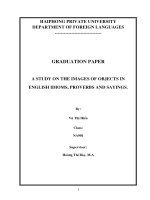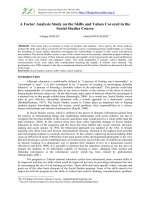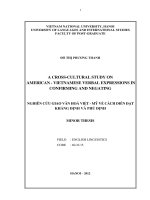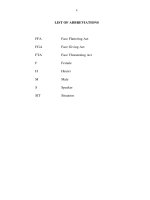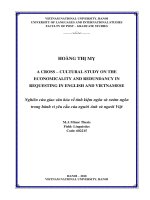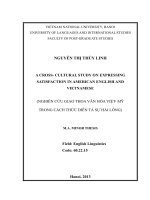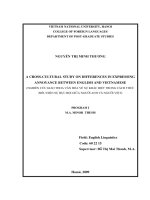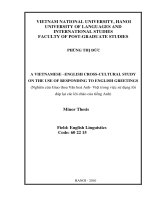A CROSS CULTURAL STUDY ON THE ECONOMICALITY AND REDUNDANCY IN REQUESTING IN ENGLISH AND VIETNAMESE
Bạn đang xem bản rút gọn của tài liệu. Xem và tải ngay bản đầy đủ của tài liệu tại đây (374.6 KB, 63 trang )
1
VIETNAM NATIONAL UNIVERSITY, HANOI
UNIVERSITY OF LANGUAGES AND INTERNATIONAL STUDIES
FACULTY OF POST – GRADUATE STUDIES
--------------
HOÀNG THỊ MỴ
A CROSS CULTURAL STUDY ON THE ECONOMICALITY
AND REDUNDANCY IN REQUESTING IN ENGLISH AND
VIETNAMESE
Nghiên cứu giao văn hóa về tính kiệm ngôn và rườm ngôn trong
hành vi yêu cầu của người Anh và người Việt
M.A Minor Thesis
Field: Linguistics
Code: 602215
HANOI – 2010
2
VIETNAM NATIONAL UNIVERSITY, HANOI
UNIVERSITY OF LANGUAGES AND INTERNATIONAL STUDIES
FACULTY OF POST – GRADUATE STUDIES
--------------
HOÀNG THỊ MỴ
ON THE ECONOMICALITY AND REDUNDANCY IN
REQUESTING IN ENGLISH A
A CROSS – CULTURAL STUDY ND VIETNAMESE
Nghiên cứu giao văn hóa về tính kiệm ngôn và rườm ngôn trong
hành vi yêu cầu của người Anh và người Việt
M.A Minor Thesis
Field: Linguistics
Code: 602215
3
By: Hoang Thi My – K16C
Supervisor: Do Thi Mai Thanh, M.A
HANOI - 2010
CERTIFICATE OF ORIGINALITY OF STUDY PROJECT REPORT
I certify my authority of the Study Project Report submitted entitled
A CROSS – CULTURAL STUDY ON THE ECONOMICALITY AND
REDUNDANCY IN REQUESTING IN ENGLISH AND VIETNAMESE
in fulfillment of the requirements for the degree Master of Arts.
4
Hoang Thi My
December 2010
ACKNOWLEDGEMENTS
I would like to express my deep gratitude to my supervisor, Mrs. Do Thi Mai Thanh, MA,
for her valuable and insightful comments and kind guidance and correction.
I take this opportunity to express my thankfulness to my colleagues and my students from
the Faculty of English Language Teacher Education, University of Languages and
International Studies, VNU for their enthusiastic support and constructive suggestions in
completing this research.
My special thanks also go to my friends, Luong Huong Thao and Pham Doan Khanh Ly,
students of University of Queensland, Australia for their information and kind help.
I am indebted to all those who have kindly advised and helped me towards the completion
of my research.
Finally, my heart – felt gratitude goes to my family members for their encouragement and
assistance throughout my training course.
5
ABSTRACT
When people from different linguistic and cultural background come into contact,
misunderstandings are inevitable, as a result of clashing rules of interaction and language
habits. This thesis was carried out to provide a cross –cultural comparison of speech
behavior in English and Vietnamese in the act of requesting, with the focus on the
popularity of redundancy and economicality in requesting; and the link between the
addresser’s/ addressee’s gender and relative age and the use of lexico modal makers seen
as redundancy – creating factors. A questionnaire was designed consisting of 3 situations to
collect data from 100 students (50 from Vietnam and 50 from English –speaking countries)
with the evenly distributed number of males and females. The collected data were
categorized into 4 groups of communicative partner: same sex but younger, same sex but
older, opposite sex but younger and opposite sex but older; and analyzed according to 14
types of lexico modal markers suggested by N.Quang and Blum-kulka
The findings of the study provide that addressee’s gender and relative status exert
considerable influence on the ways people make request. Particularly, in Vietnamese what
type of lexico modal markers can be employed for each communicative partner depends
largely on the level of politeness of such markers, whereas in English, there seems to be no
clear-cut distinction. The results also revealed that in both cultures, no significant
difference in language behavior can be found in both male and female.
The findings of the study also enable the researcher to advance some suggestions for
avoidance of communication breakdown and potential culture shock and some implications
for ELT.
6
LIST OF ABBREVIATIONS
FFA
Face Flattering Act
FGA
Face Giving Act
FTA
Face Threatening Act
F
Female
H
Hearer
M
Male
S
Speaker
SIT
Situation
7
LIST OF TABLES
Table 1: Distribution of insufficient economicality in English in 3 situations
Table 1: Distribution of insufficient economicality in Vietnamese in 3 situations
Table 3: Lexico modal markers used for communicative partner of same sex and younger
in English
Table 4: Lexico modal markers used for communicative partner of same sex and younger
in Vietnamese
Table 5: Lexico modal markers used for communicative partner of same sex and older in
English
Table 6: Lexico modal markers used for communicative partner of same sex and older in
Vietnamese
Table 7: Lexico modal markers used for communicative partner of opposite sex and
younger in English
Table 8: Lexico modal markers used for communicative partner of opposite sex and
younger in Vietnamese
Table 9: Lexico modal markers used for communicative partner of opposite sex and older
in English
Table 10: Lexico modal markers used for communicative partner of opposite sex and older
in Vietnamese
8
TABLE OF CONTENTS
Declaration..................................................................................................................................
i
Acknowledgements....................................................................................................................
ii
Abstract.......................................................................................................................................
iii
List of abbreviations..................................................................................................................
iv
List of tables................................................................................................................................
v
PART A: INTRODUCTION.....................................................................................................
1
1. Rationale and the statement of the problem.............................................................................
1
2. Aims of the study.....................................................................................................................
3
3. Significance of the study..........................................................................................................
3
4. Scope of the study....................................................................................................................
4
5. Method of the study.................................................................................................................
4
PART B: DEVELOPMENT......................................................................................................
5
9
CHAPTER 1: LITERATURE REVIEW.................................................................................
5
1.1. Speech acts and classification of speech acts.......................................................................
5
1.2. Requesting as a speech act....................................................................................................
7
1.3. Redundancy and classification of redundancy......................................................................
9
1.3.1. Redundancy........................................................................................................................
9
1.3.2. Classification of redundancy..............................................................................................
10
1.3.2.1. Modality redundancy......................................................................................................
10
1.3.2.2. Habitual redundancy.......................................................................................................
11
1.3.2.3. Insufficient redundancy..................................................................................................
11
1.4. Economicality and classification of economicality..............................................................
11
1.4.1. Economicality ..................................................................................................................
11
1.4.2. Classification of economicality..........................................................................................
11
1.4.2.1. Modality economicality..................................................................................................
11
1.4.2.2. Habitual economicaltiy...................................................................................................
12
1.4.2.3. Insufficient economicality...............................................................................................
12
1.5. Lexico modal markers...........................................................................................................
12
10
1.6. Previous studies on lexico modal markers, addresser’s/addressee’s gender and relative
age when making requests...........................................................................................................
15
CHAPTER 2: METHODOLOGY............................................................................................
18
2.1. Research design....................................................................................................................
18
2.2. Participants............................................................................................................................
18
2.3. Data collection instrument....................................................................................................
19
2.4. Data collection procedures....................................................................................................
20
2.5. Data analysis methods and procedures.................................................................................
20
CHAPTER 3: FINDINGS AND DISCUSSION......................................................................
22
3.1. The popularity of economicality and redundancy in requesting...........................................
22
3.2. The link between the addresser’s/ addressee’s gender and relative age and the use of
lexico modal makers seen as redundancy – creating factors.......................................................
24
3.2.1. The use of lexico modal markers for communicative partner of same sex and
younger........................................................................................................................................
25
3.2.2. The use of lexico modal markers for communicative partner of same sex and older........
29
3.2.3. The use of lexico modal markers for communicative partner of opposite sex and
younger.........................................................................................................................................
33
11
3.2.4. The use of lexico modal markers for communicative partner of opposite sex and
older.............................................................................................................................................
.36
PART C: CONCLUSION..........................................................................................................
40
1. Conclusions..............................................................................................................................
40
2. Pedagogical implications.........................................................................................................
41
3. Suggestions for further study...................................................................................................
42
REFERENCES...........................................................................................................................
43
APPENDIX.................................................................................................................................
I
PART A: INTRODUCTION
1. Rationale and the statement of the problem
The emergence of English as a global language has presented a solution to language barrier
and brought people closer together and its contribution towards such fields as economy,
culture, education, science, technology etc, is undeniable. Mastering a good competence of
English not only brings benefits in business, cultural exchanges, education and
development to nation-states but can benefit individuals as they will have greater career
opportunities. In the contemporary context of international integration and economic
globalization, the role of using English in communication has never been so important to
people worldwide, including the Vietnamese. The open door policy has brought the
contrasting effects (both threats and opportunities) to national economic climate with the
12
strong performance of foreign companies and the significant changes in employment
market, which is accompanied by the increasing demand of skilled and English –fluent
speaking workforce. In order to meet such requirements, English teaching programs in
Vietnam have shifted from a focus on the linguistic competence to the communicative
competence.
According to Hymes (1976), the communicative competence includes not only knowledge
of the linguistic forms of a language but the knowledge of when, how and to whom it is
appropriate to use these forms as well. In another word, when communicating, people do
not only attempt to produce grammatically correct sentences, but also try to apply them in
the right combination of context. What is more, language is also intimately bound up with
culture. There is mounting evidence that learning a language produces physiological
changes in our brain, which could affect our thoughts and perceptions. The patterns and
connections we make among various concepts may be structured by the linguistic habits of
our community. It is observed that many people from different cultures, when
communicating using one common language often impose their culture on that language.
As a result, it may be difficult for the communication process, including verbal and nonverbal communication with its influential socio-cultural factors. Thus, communicative
competence involves the understanding of culture, social knowledge and other skills of
interaction. According to J.Richard et al (1985, p.49), “when someone wishes to
communicate with others, they must recognize the social setting, their relationship to the
other person(s), and the types of language that can be used for a particular occasion. They
must also interpret written or spoken sentences within the total context in which they are
used”.
However, in Vietnam, there is a fact that English though has been taught for many years,
little attention of learners has been paid to the rules of speaking and oral practice, and even
less attention to culture-specific verbal and non-verbal behavior. Vietnamese learners tend
to translate whatever ideas they want to express into the target language with and effort of
making their utterances grammatically correct without awareness of cross-cultural
differences. Consequently, failure in applying what they have learnt to actual
communication is inevitable despite their fairly good knowledge of grammar and a
considerable amount of vocabulary. An invisible communication barrier may occur and
culture shock may happen due to their insufficient knowledge of social norms and values,
13
roles and relations between individuals. There have been many cases where the
inappropriateness of utterances has produced unwanted communication breakdown in
socio-cultural interaction.
With the aim to achieve successful communication in the real world, numerous crosscultural studies have been carried out so far to help the Vietnamese speakers of English
avoid confusion when expressing themselves, especially in situations which require
sensitive speech acts such as requesting, apologizing, etc. Requesting – one of the most
sensitive illocutionary acts in English and Vietnamese – has been the topic of so many
researches whose major findings mainly point out the basic differences between
Vietnamese and English when using politeness, directness or indirectness strategies in
requesting. However, little is known about request segments which can be seen as
redundancy and whether the redundant language elements constituting a request such as
“just a tiny bit” in English or “một chút xíu” in Vietnamese should be considered as a
politeness strategy or just a language marker by people from different cultures. More
importantly, how these redundant elements or terminologically known as “ lexico modal
marker’ or “modality markers” are linked to the addresser’s/ addressee’s gender and
relative age in both cultures requires a further clarification. All the reasons above motivate
me to conduct a research on economicality and redundancy in requesting in English and
Vietnamese culture with the hope of discovering answers to the uncertainty and promoting
awareness of cross-cultural differences in English and Vietnamese culture.
2. Aims of the study
The aims of the study are;
-
To explore the popularity of redundant and economical factors in making requests
in the specific situations, under certain variables such as age, the addresser’s/
addressee’s gender and relative age in English and Vietnamese
-
To compare and contrast the range of lexico modal markers or modality markers
constituting the redundancy and economicality in requesting in order to clarify the
similarities and differences in the way Vietnamese and English – speaking people
request in their own language and culture.
14
-
To contribute to promoting cross-cultural awareness among foreign language
teachers and learners was well as other potential interactants in cross-cultural
communication.
In brief, this paper aimed to address three following research questions:
1. Is economicality or redundancy preferred by the Vietnamese and English people
when making requests?
2.
Is the use of these economicality/redundancy factors linked to the addresser’s/
addressee’s gender and relative age?
3. Significance of the study
Although the study was carried out on a small scale, within a minor thesis of 40 pages, it is
expected to be a contributing factor to rising awareness of both Vietnamese teachers and
learners of English on the cultural similarities and differences between the two languages
when using redundancy and economicality factors in requesting. More importantly, from
the major findings of the study, Vietnamese speakers of English may get to know to use
appropriately modality markers in requesting in different situations when communicating
with English -speaking foreigners. In addition, the study is expected to be useful and
accessible to all teachers, learners and researchers as a material and reference of crosscultural communication.
4. Scope of the study
This study follows the speech act approach. It focuses mainly on verbal communication
and analysis of the data collected from the survey questionnaire. The questionnaire
designed to elicit the informant’s request forms in the proposed situations.
It is observed that redundancy factors are more popular to people when making request
than economicality ones. The study especially centers on the similarities and differences
between English and Vietnamese students in using modality markers as redundancy factors
to make requests to people of different ages and genders in some given situations. The
Vietnamese Northern dialect and the English language spoken in the United State, Great
Britain and Australia (whose cultures are referred to as Anglicist cultures) are chosen for
15
contrastive analysis. The data are collected by conducting survey questionnaires, which
enables the researcher to get information from a large population in a short period of time.
Recorded and videotaped face –to-face conversations are impossible due to limitations of
time, geographical distance and financial difficulties.
5. Method of the study
The research method used in the study is the survey research – a kind of quantitative one.
All the considerations, remarks, comments and assumptions given in the thesis are based
largely on the analysis of statistic data with due reference to publication.
The practical approaches are
-
Studying relevant publications
-
Conducting survey questionnaires
-
Analyzing the collected data
-
Resorting to personal observations and experience
-
Consulting the supervisor
-
Discussing with Vietnamese and foreign colleagues
PART B: DEVELOPMENT
CHAPTER 1: LITERATURE REVIEW
This chapter provides a brief overview of the literature review on the research topic for the
aim of laying theoretical foundation for the whole paper. Initially, key terms like “speech
acts”, “requesting”, “economicality and redundancy”, “lexico modal markers or
modality markers” are explained. Afterwards, some issues related to this research,
specifically gender and politeness strategies are also reviewed to contextualize the research
paper as well as show the gaps in the literature and how this paper could fit in. In brief, the
researchers have no ambition to review all aspects in making requests in the two
languages; this study’s literature review only covers issues connected to using redundant
16
factors in requesting and the influence of the addresser’s/ addressee’s gender and relative
age on the use of these factors.
1.1. Speech acts and classification of speech acts
Modern linguistics has been referred to as the study of language as a system of human
communication. A main observation is that la
Language can be used not only to describe the reality but also to change the existing
reality. In simple words it can be asserted ‘to speak is to act’. Linguistic acts that intend to
influence the reality are commonly called speech acts. Speech acts play an important role
in effective communication; these acts are functional units in communication.
Language can be used not just to talk about, but also to do things. Such acts performed
by language have been called speech acts, and the verbs used are known as speech act or
performative verbs. Speech acts have been divided into those in which a performative verb
actually appears (they are called explicit) and those which do not have one in their surface
structure (called primary).
The speech acts used in conversations can be divided into three basic categories:
Meta-interactive acts concern the organization of the conversation itself, i.e. the marking
of beginnings and endings (examples: now, right); the opening or closing of a conversation
(e.g. hello; bye) or the structuring of the conversation in some way (Sorry, I'm afraid I must
go now). Turn-taking acts are used to pass on, hold, or obtain the floor in public speaking
(what do you think?; if I may just finish this; could I come in on this?). Interactive acts
consist of eliciting acts, which require some linguistic response, like asking for
information, a decision, agreement, or the clarification or repetition of an utterance;
informing acts, which offer information or respond in other ways to eliciting acts, like
agreeing, confirming, qualifying or rejecting; acknowledging acts, which provide positive
or negative follow-up or feedback, directing acts, which ask for an immediate or future
action.
According to Austin (1962), there are three related acts. They are locutionary,
illocutionary, and perlocutionary. These are three distinct levels of action beyond the act
of utterance itself. Locutionary acts are simply the speech acts that have taken place.
Illocutionary acts are the real actions which are performed by the utterance, where saying
17
equals doing, as in betting, welcoming and warning. For example, we might produce
utterance “Could you open the door, please?” to perform an act of requesting. The
intention of requesting in this act is generally termed as the illocutionary force. And finally,
perlocutionary acts are the effects of the utterance on the listener. Depending on the
circumstances, S will utter “Could you open the door, please?” on the assumption that H
will recognize the effect S intended. Once the S’s intention is recognized by H, the act is
generally known as having the perlocutionary effect.
According to Yule, G. (1996, p.49), of these three dimensions, illocutionary force is most
frequently discussed. Indeed, the term “speech act” is generally interpreted as the
illocutionary force of an utterance. For example, the utterance “It’s stuffy here” can
represent different illocutionary forces such as a request, a complaint, a warning, etc.
However, which illocutionary act is performed depends on how the utterance fits into the
particular circumstances.
Speech acts may be conveniently classified by their illocutionary type, such as asserting,
requesting, promising, and apologizing, for which we have familiar verbs. These difference
types may in turn be distinguished by the type of attitude S expresses. As a result, there are
thousands of possible illocutionary acts. However, such classifications are difficult because
S’s intentions are not always clear.
According to Searle (1969), there are five types of speech acts based on S’s intentions.
They are declaratives, representatives, expressive, directives, and commissives.
A declarative is speech act, where the speaker brings about some state of affairs by the
mere performance of the speech act (declare, bequeath, appoint, excommunicate). For
example, “The paper for the Busan conference is accepted”. Representatives are those
kinds of speech acts that state what S believes to be the case or not. For example, “The
earth moves around the sun”. An expressive is a speech act, the purpose of which is to
express the speaker’s attitude to some state of affairs (thank, congratulate, apologize,
condole, deplore, welcome). For example, “I like the ideas presented in this conference”.
Directives are those kinds of speech acts that S uses to get H to do something. They
express what S wants. They are commands, orders, requests, etc. For example, “Could you
open the door, please?. Commissives are those kinds of speech acts that S uses to commit
18
themselves to some future actions. They express what S intends. They are promises,
threats, refusals, etc. For example, “I’ll do it”.
Speech acts can also be classified based on the directness of an utterance. A direct speech
act is an act in which the illocutionary force is built into the structure of the sentence. For
example, with the utterance “stop making noise”, the hearer understands the illocution in
the utterance to be a directive without much difficulty or misunderstanding. Indirect ways
of getting things done by language are called indirect speech acts. For example, if you are
sitting at the only fast computer in the department ten minutes before nine and a colleague
comes in and asks 'Are you teaching at nine?', the question is “what does he want?” When
you answer 'No, I am not' and he goes away without saying anything else it is likely that he
wanted to get on the computer to do his work but did not want to ask you directly. Another
indirect way to ask would be “Are you going to be long?’ which also avoids the direct
question “Can I get on the computer?”
The analysis of speech acts is not only for illustrating the kinds of things we can do with
words but also necessary for identifying some of the conventional utterance forms we use
to perform some specific actions. However, a more extended interaction should be taken
into consideration so that we could understand how those actions are carried out and
interpreted with speech events. The following part will discuss requesting as a speech act.
1.2. Requesting as a speech act
Oxford Advanced Learner’s Dictionary defines requesting as “an act of asking for
something in speech or writing, especially politely”. Requesting behavior offers a
particularly fertile ground for the study of any potential cross culture study. This is mainly
because together with thanking, complementing, inviting, etc, requesting is regarded as one
of the most sensitive illocutionary acts in communication.
In terms of speech acts, requesting is considered to be an act of requiring the other(s) to do
something performed through utterances in interactions. A request expresses a desire for
the addressee to do a certain thing and normally aims for the addressee to intend to and
indeed, actually do that thing. For example, when we utter a sentence like: “Would you
pass me the salt, please?” pragmatically we produce an utterance containing an act of
asking the listener to pass us the salt.
19
Searle (1969:66) offer this description of a request: a directive speech act which counts an
attempt to get H to do an act which S wants H to do, and which S believes that H is able to
do; and which it is not obvious that H will do in the normal course of events or of H’s own
accord. This notion of an “act” may include the purely verbal acts of giving information, or
granting permission.
As other communication processes, requesting is composed of, at least, three factors: the
speaker, the hearer, and their language. The speaker is directed to the final goal, when
he/she has a request in her/his mind. As “the generator of meanings” (Leech, 1985), the
speaker makes some utterances in order to achieve the goals. On the other hand, the hearer,
“the interpreter of meaning”, is expected to reconstruct the communicative intention of the
speaker. We must bear in mind that achieving the goal depends mainly on the hearer, not
on the speaker. It is because if the hearer fails to interpret the communicative intention of
the speaker, it cannot be regarded as requesting. The speaker’s violation of the
Conversational Maxim (Grice, 1975) will help the hearer’s interpretation.
A request may vary in strategy type and level of directness. Three levels of directness for
requests have been identified (cf. Blum-Kulka, House & Kasper 1989). The first is
“direct”. This includes forms that convey requestive force by purely syntactic means, such
as grammatical mood or an explicit performative verb. The second level is “conventionally
direct”. This comprises indirect formulas that are conventionalized in the language as a
means of requesting. The last level is “non-conventionally indirect”. This refers to hints,
indirect request forms that are not conventionalized in the language, and hence require
more inference by the hearer in order to derive the speaker’s requestive intent. Although it
may not so overt at times, cultures have been found to differ as to which factors count
more than others, and languages vary in the extent to which they switch directness levels
by situation (Blum-Kulka et al., 1989). Some of the social/situational factors include:
-
Relative dominance of the requester in relation to the hearer.
-
Relative social distance (familiarity) between the interlocutors
-
Hearer’s degree of obligation in carrying out the request
-
The right the speaker has to issue the request
-
Estimated degree of difficulty the speaker has in making the request
-
Estimated likelihood of compliance on the part of the hearer
20
“In broad terms, research seems to support our claim that three sociological factors are
crucial in determining the level of politeness which a speaker (S) will use to an addressee
(H): these are relative power (P) of H over S, the social distance (D) between S and H, and
the ranking of impositions (R) involved in doing the face-threatening act (FTA)” (Brown
and Levinson, 1987: 15)
From the analysis above, we can see that a request can be made in a direct or indirect ways
and it is true to say that requesting is one kind of speech acts used variously and widely in
interaction
1.3. Redundancy and classification of redundancy
1.3.1. Redundancy
According to Longman dictionary of English language and culture, redundancy, in general
usage can be defined as “more of anything than is (strictly) needed, usually resulting from
repetition or duplication: pleonasm or tautology”. Languages differ in the degree and
kinds of redundancy they make use of: Latin syntax has a much higher level of redundancy
than English syntax; French often has greater redundancy in writing than in speech. It is a
convention of English style that words should be varied rather than repeated, for example,
“It was a great enormous house, the biggest I’ve ever seen” rather than “It was a large
large house, the largest I’ve ever seen”. Different phrasing is intended to decrease
monotony and perhaps increase the amount of information conveyed. Repetition is,
however, a common activity and has traditionally been justified as a rhetorical device, used
for emphasis and the expression of emotion. It was lexically and grammatically redundant,
but not emotionally.
According to Prof. Nguyen Quang (1998), redundancy means that a message contains
more information than is needed for it to be understood. In another word, redundancy can
be described as the difference between the possible and actual information in a message.
This difference may be repetition or other encoding beyond the real essential information,
for example, “Could you please repeat it again?”. In this example, “again” is a redundant
word because it is a repetition of “repeat”. Redundancy in language is a popular
phenomenon across different cultures, Vietnam included. Some previous studies revealed
that Vietnamese is different from native speakers of English in terms of
thought patterns. When making request members of Vietnamese culture
21
tend to be much more indirect than people from English culture. As a
result, when examining Vietnamese requests, we find out more
redundant factors than in English, for example “Làm ơn cho em biết bưu điện
ở đâu ấy nhỉ?.
1.3.2. Classification of redundancy
Prof. Nguyen Quang also categorized redundancy into three main types: Modality
redundancy, habitual redundancy, insufficient redundancy.
1.3.2.1. Modality redundancy
Modality redundancy is considered as the repetition of a word or phrase. In fact, it can
create rhetorical effectiveness for the text and the speech. Modality redundancy is created
in order to emphasize the meaning, create sound impression or produce the rhythm in
literature.
For example, in English “Thousands of innocent people were killed in New
Yorkby bombing that was leaded by, was done by, was sponsored, was supported by Bin
Laden”. In this example, the verb “was” and passive structure are repeated in order to
emphasize on the devastating effects and cruelty caused by Bin Laden’s terrorist attack. In
Vietnamese, especially poetry, modality redundancy is mainly applied as a way of
producing the rhythm.
Ta muốn riết mây đưa và gió lượn
Ta muốn say cánh bướm vơí tình yêu
Ta muốn thâu trong một cái hôn nhiều.
1.3.2.2. Habitual redundancy
Habitual redundancy is in fact a type of conventional discourse structures and mainly used
in a certain community of people. For instance, English people might say “In my opinion, I
think that the bird seems to be saying to us” without noticing that in my opinion or I think
is a kind of habitual redundancy which is caused by their language habits. Vietnamese
people share the same situation; e.g.“Theo ý tôi thì tôi cho rằng anh nên xuống xe”
1.3.2.3. Insufficient redundancy
22
Insufficient redundancy is used by those who have limited knowledge and poor skill at
expressing ideas. Among three types of redundancy, it is most confusing and ambiguous
and likely to cause misunderstanding. For example, in Vietnamese “Hôm nay thì thế này ạ,
tôi mời ông bà dến thưa chuyện của cháu”, in English “Oh, well, um, really, I …I
am finding ,um, …my ring. It may, um, be somewhere here, but…but
there ‘s nothing”
1.4. Economicality and classification of economicality
1.4.1. Economicality
In contrast to redundancy, economicality is defined by Nguyen Quang as a kind of
language contraction, particularly a form of lexico-contraction but still can be understood
in context. For example, there is a situation between a couple. The husband enters the room
without closing the door. When making a very economical utterance “door’, the wife
actually performs an act of requesting to the husband to close the door.
1.4.2. Classification of economicality
1.4.2.1. Modality economicality
Modality economicality is seen as the contraction of words or phrases of least importance
in conveying meanings of a message. The hearer needs to put the utterances in the context
so that she/he can understand what they really mean.
For example, in English “Much have I had lots of dreams and many nice angels
seen” and in Vietnamese “Giá mà cứ như thế này mãi thì thích nhỉ!”
Actually this is related to an adversarial pair of dimension: high context and low context.
In low context cultures, people rely heavily on the context to understand the intended
meaning from contracted language, for example: Yes, I do for the request Do you mind
opening the door ? or Me, too for the exclamation I can’t stand him any more.
1.4.2.2. Habitual economicality
Habitual economicality is common in both English and Vietnamese. Habitual redundancy/
economicality refers to non-conventional discourse structures, for example “(Tôi) nói khí
không phải”/ “Năm thì mười hoạ” or “In my opinion/Frankly (Frankly speaking)” both
(either) grammatically and (or) lexically contracted… They can be idiomatic expressions
23
like “Dã man” (terrible) for “Cậu thật quá đáng” (You are so wicked) or non-idiomatic or
habitual/ colloquial expressions like ‘nói cho vuông’, ‘thẳng toẹt ra là’ (frankly)
1.4.2.3. Insufficient economicality
Insufficient economicality is commonly seen among these who have poor ability to express
ideas or among small children. For example,
In English:
In Vietnamese
I go to market
Mẹ ơi, Nam muốn cơm
I not want eat
Bố mẹ đi ông bà ngoại
The definition of redundancy and economicality, especially their classification suggested
by Prof. Nguyen Quang serve as a basis for the researcher to carry out this study. However,
in my experience and observation, when making requests, in order to obtain the goals,
various request segments and redundant factors are used by the speakers and most of which
are lexico modal markers or modality markers such as “please, just a little bit, perhaps,
come one” in English or “ạ, dạ, làm ơn, chút xíu thôi, nhé, ấy nhỉ” in Vietnamese. In the
following part of this chapter, a theoretical review of lexico modal markers will be
included to provide a deep insight into their roles and uses in requesting.
1.5. Lexico modal markers
One of the ways to realize politeness strategies is via lexico modal markers. Lexico modal
markers are types of modifications for achieving different effects of realizing speech acts.
Lexico modal markers are considered to be the most useful means of language to express
people’s feelings, attitudes…towards states or events. N.Quang (1999:219) assumes that
lexico-modal markers are to reduce face threatening act (FTA) or to enhance face giving
act (FGA), to intensify or soften, to assert and/or emphasize people’s attitude.
Trosborg (1987: 97, 69) and N.Quang (1999: 219) suggest nine types of lexico modal
markers, which, in their opinion, can create different degrees of politeness. Personally,
lexico modal markers are the most popular factors creating the redundancy in requesting.
Moreover, each lexico modal marker has its own meaning and function and how to use
them to make requests depends largely on the relationship between the addressers and
addressees especially their gender and relative age.
24
Types of lexico modal markers appear commonly in requesting are (following N.Quang
and Blum Kulka):
1. Consultative devices: S seeks to involve H and bids for H’s cooperation
E.g. “Do you know the way to the Post Office?
“Anh có biết đường đến Bưu điện không?
2. Understaters: To minimize parts of the proposition or to reduce FTA
E.g “Could you show me the reason just a tiny bit, please?
“Xin anh cho em biết lý do dù chỉ một chút được không?
3. Hedges: to avoid specification in making commitment to the illocutionary point of the
utterance.
E.g. “Tell me the why if you could”
“Nếu có thể bác cho cháu biết lý do anh ấy làm như vậy.’
4. Downtoners: Elements which S modulates the impact of the utterance on the H to
express tentativeness of emphasizing factors.
E.g. “Would you be able perhaps to stop littering now?
“Có lẽ việc dừng vứt rác không khó gì với chị chứ ạ?
5. Intesnsifiers: Elements by means of which the S over-presents the reality denoted in the
proposition.
E.g. “Tell me where the Post Office is. The map is so confusing
“Bảo cho em đường đến bưu điện với. Nhìn bản đồ rối rắm quá”
6. Subjectivisers: Elements which show S’s opinion, attitude, etc, towards the proposition
E.g. “I know it’s not easy to speak out, but could you tell me the reason?”
“Cháu biết nói ra không dễ gì. Nhưng bác có thể cho cháu biết lý do ko?
7. Commitment upgraders: elements which express the commitment to the proposition
(sure, certain, positive…)
E.g. “I’m sure you know the way to the city center, don’t you?”
“Chị chắc em biết đường đến bưu điện, phải không?
25
8. Cajolers: consists of gambits functioning at interpersonal level of discourse to
harmonize the relationship between two communicative partners (you know, you see..)
E.g. “Come on, stop littering for the health of others.”
“Thôi nào, em hãy dừng vứt rác vì sức khỏe của người khác với chứ”
9. Appealers: elements to appeal the response from H, usually with approval and
agreement (Ok, right, don’t you think…)
E.g. “You’ll stop littering, right?
“Anh sẽ không vứt rác nữa, được chứ?”
10. Politeness markers: elements which show difference to H or mitigate face-threats of
the utterance like “please”, “dạ”, “ạ”…
E.g. “Which way to the Post Office, please?
“Làm ơn cho em/anh/chị/cháu biết bưu điện ở đâu ạ?”
11. Grounders: S indicates the reason for the requests (like “basically, “so”, “as”, “the
fact is that”, “that’s how it really is…”)
E.g. “Would you mind showing me the way to the Post Office? The fact is that I can’t read
the map”
“Anh làm ơn chỉ đường cho em tới bưu điện được không. Thực ra là em không biết đọc
bản đồ”
12. Sweeteners: by expressing exaggerated appreciation of the H’s ability to comply with
the request, the S lowers the imposition involved.
E.g. “It’s very kind of you to tell me the reasons”
“Bác yêu quý, bác thật tốt nếu nói cho cháu biết lý do tại sao”.
13. Disarmer: The S indicates his awareness of potential offense, thereby attempts to
anticipate possible refusal.
E.g. “Is there any possibility you could show me the way to the Post Office?”
“Anh xem nếu có thể được thì chỉ đường cho em ra bưu điện với được không?
14. Cost minimize: The S indicates consideration of the cost to the H involved in the
compliance with the request.
